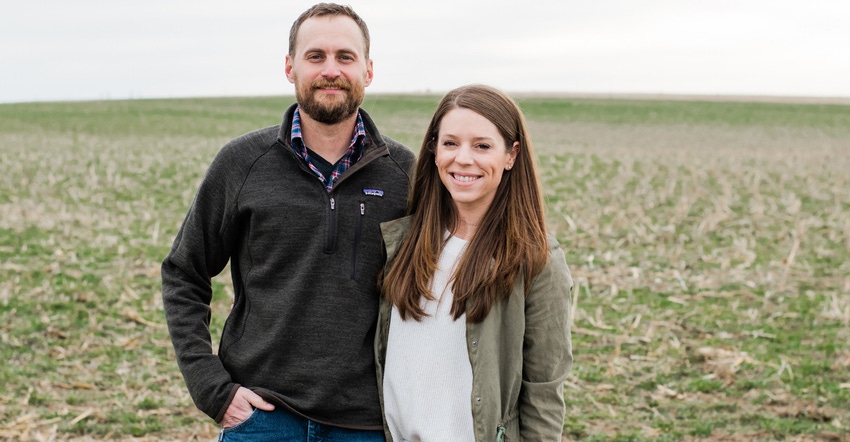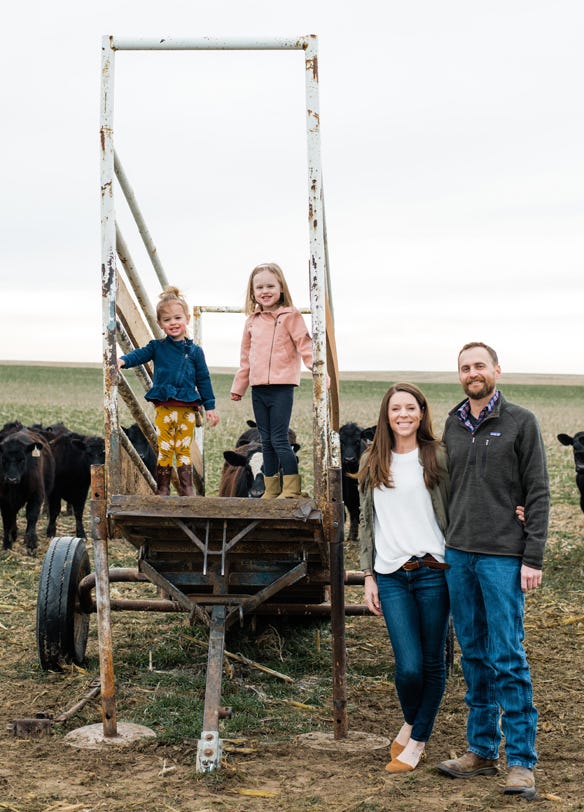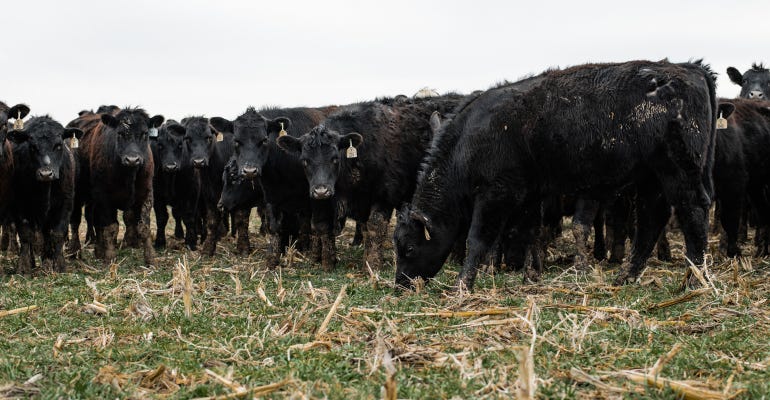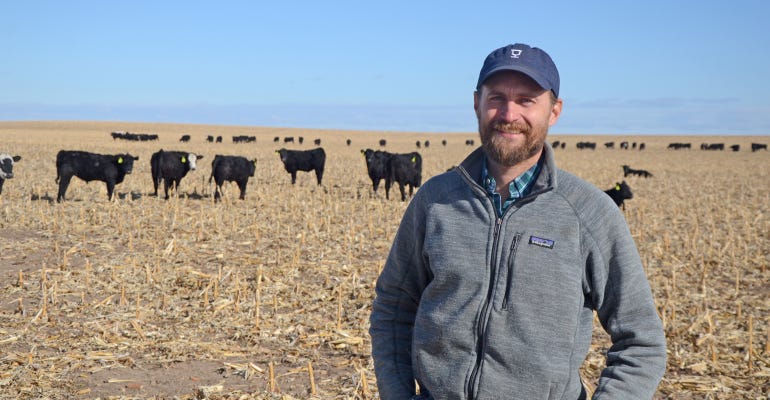
First dates can be nerve-wracking, especially when you tell your date, a born-and-raised southern Californian, that you intend to return to the family ranch in western Nebraska.
That was the case for Logan Pribbeno, who is now operations manager for Wine Glass Ranch near Imperial, Neb. Pribbeno met his wife, Brianna, while working for a consulting firm in San Francisco.
"My wife is from Huntington Beach, Calif.," Logan says. "I always did know that I was coming back, and on our first date, I had to tell her I was moving to Nebraska, and by Nebraska, I don't mean Omaha. I dated a couple of women in California, and that was a shocker for most of them. But for my wife, Brianna, it was, 'Oh, that sounds like a lot of fun.'"
Logan moved to California on the advice of his dad, Jeff Pribbeno.
"Up until I was about 18, I didn't think that I wanted to be involved in ag or the operation," Logan says. "When I was 18, I really fell in love with the Plains ecosystem. It was a requirement by my family that I had to study outside of agriculture and work outside of ag for 10 years."
Adjusting to management
After graduating from the University of California-Santa Barbara with a degree in economics in 2006, Logan worked for a firm in the San Francisco Bay Area for five years, doing financial consulting, accounting, tax preparation and IPO (initial public offering) consulting. This involved working with startup companies in the Bay Area to help improve their financial record keeping.
In 2012, Logan and Brianna returned to the ranch that's been in Logan's family for four generations — going from a place with more than 17,000 people per square mile to a county with about 4,000 people.
"It was a massive lifestyle shift, and it took longer than we thought to adjust," Logan says. "My wife worked in advertising at the San Francisco Chronicle. When we moved here, she was a waitress and cleaned rooms at a local bed and breakfast. Now, she's a social media manager for Allo. So, it was just a temporary shift, but it did take several years to find our bearings."

MAKING ADJUSTMENTS: Logan and Brianna Pribbeno are pictured with their two daughters, Prairie, 2 (left), and Pearl, 4 (right). For Logan Pribbeno, moving back to his family's ranch from California meant adjusting to a role in a management position — including the endless list of tasks that needed to be done on a daily basis.

For Logan, this meant adjusting to a role in a management position.
"I remember succinctly I was planting corn in the middle of May in 2012," he says. "It started raining. I couldn't finish planting, so I went home, and I didn't do anything because I didn't fully understand the 10,000 things that needed to be done. It takes a certain skill set to just flip it off, flip it on."
With numerous tasks to take on, Logan had to learn how to delegate. While he serves as operations manager, Jeff serves as CEO at Wine Glass. They also have a cow-calf manager, a stocker manager, a farm operator and three production associates who are hourly employees.
"My great-grandfather was a poet and a fence-post sculptor," Logan says. "His advice was, 'Management is the art of concealing disappointment,'" Logan says. "When you delegate, it's never going to get done up to your expectations. As a manager, from day one, you need to throw that out the window."
Culture of innovation
When Logan came on board in 2012, the environment was primed for adopting new practices.
The ranch was founded by Logan's great-great-grandparents, Sherman and Susy McCoy, as the Lonestar Ranch. When it was owned by Logan's great-grandparents, A.O. and Mary Stanger, the name was changed to Wine Glass — which made for a simpler brand design. Logan's dad, Jeff, adopted practices such as ecofallow winter wheat and no-till in the 1970s, and rotational grazing in the 1990s.
Jeff Pribbeno recalls experimenting with ecofallow wheat in the 1970s, when his dad, Bill Pribbeno, and grandfather A.O. allowed him to try it on the condition that he get his own revolving line of credit.
"Of course they thought I was crazy, which I was," Jeff jokes. "But they allowed me to experiment. As it started to show success, it didn't take long for it to catch on, and now it's the standard. I was fortunate I was allowed the flexibility to try it, and was brought up that way. Logan has the flexibility to try a lot of new things, and he's encouraged to change the business for the future. For a business to survive more than one generation, it requires new ideas."

IMPLEMENTING NEW PRACTICES: When Logan came on board in 2012, the environment was primed for adopting new practices. Logan's dad, Jeff, adopted practices such as eco-fallow winter wheat and no-till in the 1970s, and rotational grazing in the 1990s. Logan's contribution has involved annual forage crops, including winter annuals such as cereal rye, seen here.

Logan's contribution has involved annual forage crops, including winter and summer annuals.
He prefers winter annuals such as cereal rye and triticale on rented irrigated acres, while summer annuals typically are seeded on dryland acres. Summer forage crops such as sorghum sudangrass are a good fit for this dryland environment, where most of the limited amount of annual precipitation falls during spring and summer.
"It fits us in a very unique way, where we can manage thousands of animals very efficiently and effectively," Logan says. "We can grow Iowa corn. I can plant 33,000 population corn on my dryland acres, and it will grow and look great, but it won't produce an ear. I have the soils, I have everything else I need, but I don't have the water to produce grain. We're uniquely situated where we can grow as much forage as you can in eastern Nebraska, and we can pay a fraction of the rent."
When it comes to summer annuals, they typically graze it once and move on — harvesting about 20% to 30% of the biomass of forages such as sorghum sudangrass, which helps retain soil moisture and also build organic matter through greater residue and spreading livestock manure.
Reaping the benefits
After building up their soil with nearly 40 years of no-till, 20 years of manure applications, and now grazing forage crops, the Pribbenos have been able to cut back on nitrogen fertilizer applications and completely eliminate phosphorus fertilizer applications.
At Wine Glass, rotational grazing involves giving each paddock 100 days of rest in the year. Each paddock is typically grazed twice a year for about a week. So, 90% of the ranch is resting at any given point in the year. This give more desirable forages a chance to regrow.
"It requires a lot of management," Jeff says. "You don't just put cattle out and go to town. We see every group of cattle every day; that's a requirement. The benefit is we have the flexibility to manage each paddock that way, and prevent overgrazing in that particular paddock if that's the case."

GRAZIER FIRST: Logan Pribbeno often tells people he's a grazier first. "It's a lot cheaper to have an animal harvest forage and distribute nutrients rather than machinery," he says. "Anytime we can get animals on and machinery off is a benefit, purely from a cost standpoint. I'm an economist, and the fact that there are soil health benefits is really a cool bonus."

Over time, they've built hundreds of miles of fence — all high-tensile wire — as well as 120 water sites. This includes tire tanks and 11-foot steel-bottom tanks, fed by 2-inch lines fed by two or more wells to ensure all sites have water, even if one well goes down.
And, it didn't take long to realize benefits from rotational grazing, with more growth of species such as sand bluestem and big bluestem early on, and indiangrass taking off later.
"Within two or three years, we had key grasses come back very strong — primarily sand bluestem, which is a very desirable plant for cattle," Jeff says. "I had not seen sand bluestem until we started rotational grazing. It's come back to the level it's supposed to be, at climax vegetation state."
Planning for the future
Logan came back to the ranch in the middle of one of the biggest booms in the ag economy in several generations. Of course, the ag economy is in a different state now. While many operations have expanded by adding more land, the Pribbenos are taking a different strategy for growth.
"Adding more land has been a good recipe for success in previous generations," Logan says. "For us though, we are not growing that way. We want to be the premier grazing outfit in southwestern Nebraska. Part of our growth is going to be through buying cattle that appreciate — in particular yearlings, because they appreciate every year — and buying less equipment."
Logan explains they plan to continue to partner with grain farmers to graze forage crops, crop residue, and allowing those producers to reap the soil health benefits of grazing.
Their plans also include getting the most out of every acre through practices such as managed grazing, eliminating fallow and incorporating forage crops on their own acres, to grow without increasing land base costs.
Finally, they also are working with young producers who have leased rangeland, which helps mitigate risk taken for those producers, so they don't have to borrow money to stock that rangeland.
While soil health is a major benefit of these practices, Logan's primary goal is profitability.
"I always tell people I'm a grazier first, and soil health is great — a wonderful added benefit to grazing," he says. "It's a lot cheaper to have an animal harvest forage and distribute nutrients rather than machinery. Anytime we can get animals on and machinery off is a benefit, purely from a cost standpoint. I'm an economist, and the fact that there are soil health benefits is really a cool bonus."
About the Author(s)
You May Also Like






